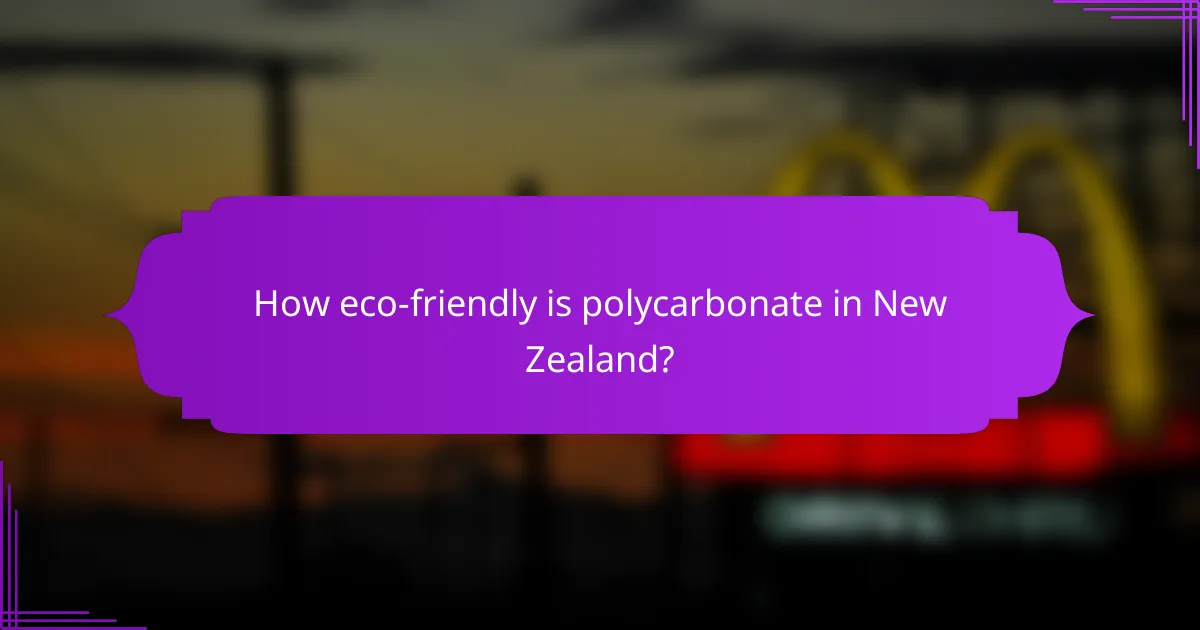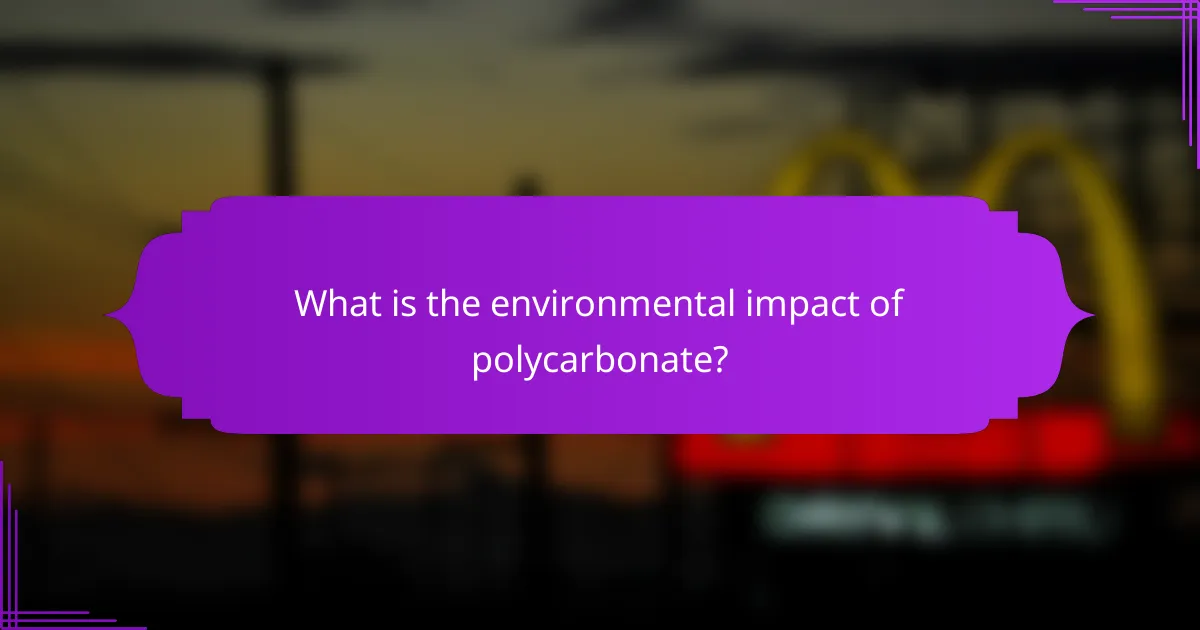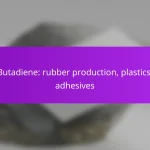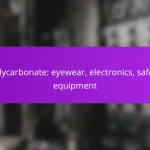Polycarbonate is a durable and recyclable plastic that presents a relatively eco-friendly option, especially in New Zealand. Although it is not biodegradable, its longevity and recycling potential help address some environmental concerns. Specialized facilities can recycle polycarbonate through mechanical and chemical processes, yet improper disposal can lead to significant waste and ecological harm.

How eco-friendly is polycarbonate in New Zealand?
Polycarbonate is relatively eco-friendly in New Zealand, particularly due to its durability and recyclability. While it is not biodegradable, its long lifespan and potential for recycling mitigate some environmental concerns.
Low carbon footprint
Polycarbonate typically has a lower carbon footprint compared to other plastics, primarily due to its efficiency in production and longevity. Its durability means that products made from polycarbonate do not need to be replaced as frequently, reducing overall waste and emissions over time.
In New Zealand, the carbon footprint can be further minimized by choosing locally sourced polycarbonate products, which reduces transportation emissions. Consumers can look for certifications that indicate lower environmental impact during production.
Energy-efficient production
The production of polycarbonate is generally energy-efficient, utilizing advanced manufacturing processes that consume less energy than many other plastics. This efficiency is crucial in New Zealand, where energy sources are increasingly shifting towards renewable options.
Manufacturers are adopting practices that not only lower energy consumption but also incorporate recycled materials into the production process. This not only conserves resources but also aligns with New Zealand’s sustainability goals.
Biodegradability challenges
One of the main challenges with polycarbonate is its lack of biodegradability. Unlike natural materials, polycarbonate can persist in the environment for many years, contributing to plastic pollution if not properly managed.
In New Zealand, it is essential for consumers to be aware of recycling options available for polycarbonate products. Many local councils offer recycling programs, but it is important to check specific guidelines to ensure proper disposal and recycling to minimize environmental impact.

What are the recycling options for polycarbonate?
Polycarbonate can be recycled through specialized facilities that process this durable plastic. Options include mechanical recycling, where the material is ground and remolded, and chemical recycling, which breaks it down to its original monomers for reuse.
Recycling facilities in New Zealand
In New Zealand, recycling facilities that accept polycarbonate are limited but growing. Many local councils provide drop-off points for plastics, including polycarbonate, while specialized companies focus on recycling this material. It’s essential to check with local waste management services for specific locations and guidelines.
Recycling process for polycarbonate
The recycling process for polycarbonate typically involves collection, sorting, and cleaning of the material. Once sorted, the polycarbonate is shredded into small pieces, which are then melted down and formed into pellets that can be used to manufacture new products. This process helps reduce waste and conserve resources.
Recycling rates and statistics
Recycling rates for polycarbonate are generally lower compared to other plastics, often falling in the single-digit percentage range. Factors influencing these rates include the availability of recycling facilities and public awareness. Increasing education on the importance of recycling polycarbonate can help improve these statistics over time.

What is the environmental impact of polycarbonate?
The environmental impact of polycarbonate primarily revolves around its durability and resistance to degradation, which can lead to long-term pollution. While polycarbonate is recyclable, improper disposal often results in significant waste accumulation in landfills and potential harm to ecosystems.
Impact on wildlife
Polycarbonate waste can pose risks to wildlife, particularly in aquatic environments where plastic pollution is prevalent. Animals may ingest small plastic particles, leading to health issues or death. Additionally, larger pieces can entangle marine life, disrupting ecosystems and food chains.
Efforts to mitigate these impacts include promoting responsible disposal and recycling practices. Public awareness campaigns can help educate communities on the importance of reducing plastic waste and protecting local wildlife.
Landfill concerns
To address landfill concerns, it is crucial to enhance recycling programs and encourage the use of recycled materials in manufacturing. Communities can implement local initiatives to collect and process polycarbonate waste, reducing the amount sent to landfills.
Comparative analysis with other plastics
When compared to other plastics, polycarbonate is more durable but less biodegradable, which raises environmental concerns. While materials like PET are widely recycled, polycarbonate recycling rates remain lower due to limited facilities and awareness.
Understanding the differences in recycling capabilities can guide consumers and manufacturers in making more eco-friendly choices. Opting for materials with higher recycling rates can help reduce overall environmental impact.

What are the benefits of using recycled polycarbonate?
Recycled polycarbonate offers significant advantages, including reduced environmental impact and enhanced resource efficiency. By reusing this material, industries can conserve resources and minimize waste, contributing to a more sustainable future.
Resource conservation
Using recycled polycarbonate helps conserve natural resources by reducing the need for virgin materials. This process lowers the demand for petroleum, which is the primary raw material for polycarbonate production. By recycling, manufacturers can significantly decrease their carbon footprint and energy consumption.
Additionally, recycling polycarbonate reduces landfill waste, as it repurposes materials that would otherwise contribute to environmental degradation. This practice aligns with global efforts to promote a circular economy, where materials are reused and recycled instead of discarded.
Cost-effectiveness
Recycled polycarbonate can be more cost-effective than its virgin counterpart. The production process for recycled materials often requires less energy, which can translate to lower manufacturing costs. Companies that utilize recycled polycarbonate may benefit from reduced material expenses, leading to overall savings.
Furthermore, as the market for recycled materials grows, economies of scale can drive prices down. Businesses that invest in recycled polycarbonate may find themselves more competitive, especially as consumers increasingly favor eco-friendly products.
Market demand for recycled materials
There is a rising market demand for recycled polycarbonate, driven by consumer preferences for sustainable products. Many companies are now prioritizing eco-friendly materials in their supply chains, creating a robust market for recycled options. This trend is evident across various industries, including automotive, electronics, and construction.
As regulations around plastic use tighten globally, businesses that adopt recycled materials may gain a competitive edge. Staying ahead of this trend can help companies meet consumer expectations and comply with environmental regulations, further enhancing their market position.

How does polycarbonate compare to other materials?
Polycarbonate is often favored for its durability and lightweight properties compared to other materials. Its impact resistance and versatility make it a popular choice in various applications, but it also has environmental considerations that differ from alternatives like glass, acrylic, and traditional plastics.
Polycarbonate vs. glass
When comparing polycarbonate to glass, polycarbonate is significantly lighter and more impact-resistant. While glass can shatter easily, polycarbonate offers a safer option for applications where breakage is a concern, such as in safety goggles or greenhouse panels.
However, glass has superior optical clarity and scratch resistance, making it preferable for applications requiring high transparency, like windows and display cases. The choice between the two often depends on the specific requirements of the project, including weight, safety, and clarity.
Polycarbonate vs. acrylic
Polycarbonate and acrylic are both lightweight and shatter-resistant, but polycarbonate is generally more durable and resistant to high temperatures. Acrylic is more prone to scratching and can become brittle over time, while polycarbonate maintains its integrity under stress.
In terms of cost, acrylic is usually less expensive than polycarbonate, making it a popular choice for budget-sensitive projects. However, for applications requiring high strength and impact resistance, polycarbonate is often the better investment.
Polycarbonate vs. traditional plastics
Compared to traditional plastics, polycarbonate offers superior strength and thermal stability. While materials like PVC or polyethylene are common in many applications, they often lack the durability and heat resistance that polycarbonate provides.
Additionally, polycarbonate can be recycled, which is a significant advantage over some traditional plastics that may not be accepted in recycling programs. This eco-friendliness can influence the decision for environmentally conscious consumers and businesses looking to reduce their carbon footprint.

What are the future trends in polycarbonate recycling?
Future trends in polycarbonate recycling focus on improving efficiency and expanding capabilities to handle various forms of polycarbonate waste. Innovations in technology and shifts in consumer behavior are driving these changes, aiming to enhance sustainability in the industry.
Innovative recycling technologies
New recycling technologies are emerging to process polycarbonate more effectively. Mechanical recycling methods are being refined to recover high-quality materials, while chemical recycling techniques are gaining traction, allowing for the breakdown of polycarbonate into its original monomers for reuse.
For example, advanced pyrolysis processes can convert polycarbonate waste into valuable fuels or feedstock, reducing landfill contributions. These innovations not only improve recycling rates but also lower the carbon footprint associated with polycarbonate production.
Regulatory changes in New Zealand
New Zealand is implementing stricter regulations aimed at enhancing recycling efforts for polycarbonate and other plastics. The government is promoting initiatives that encourage manufacturers to adopt sustainable practices and improve the recyclability of their products.
These regulatory changes may include incentives for companies that invest in recycling technologies or penalties for those that fail to comply with new environmental standards. As a result, businesses are likely to prioritize eco-friendly practices in their operations.
Consumer awareness and demand shifts
Consumer awareness regarding the environmental impact of polycarbonate is increasing, leading to a greater demand for recycled products. As sustainability becomes a priority for many consumers, brands that emphasize eco-friendly materials are likely to gain a competitive edge.
Shifts in consumer preferences are prompting companies to explore sustainable sourcing and recycling options. This trend encourages manufacturers to invest in recycling technologies and adopt practices that align with consumer values, ultimately driving the market towards more sustainable polycarbonate solutions.


